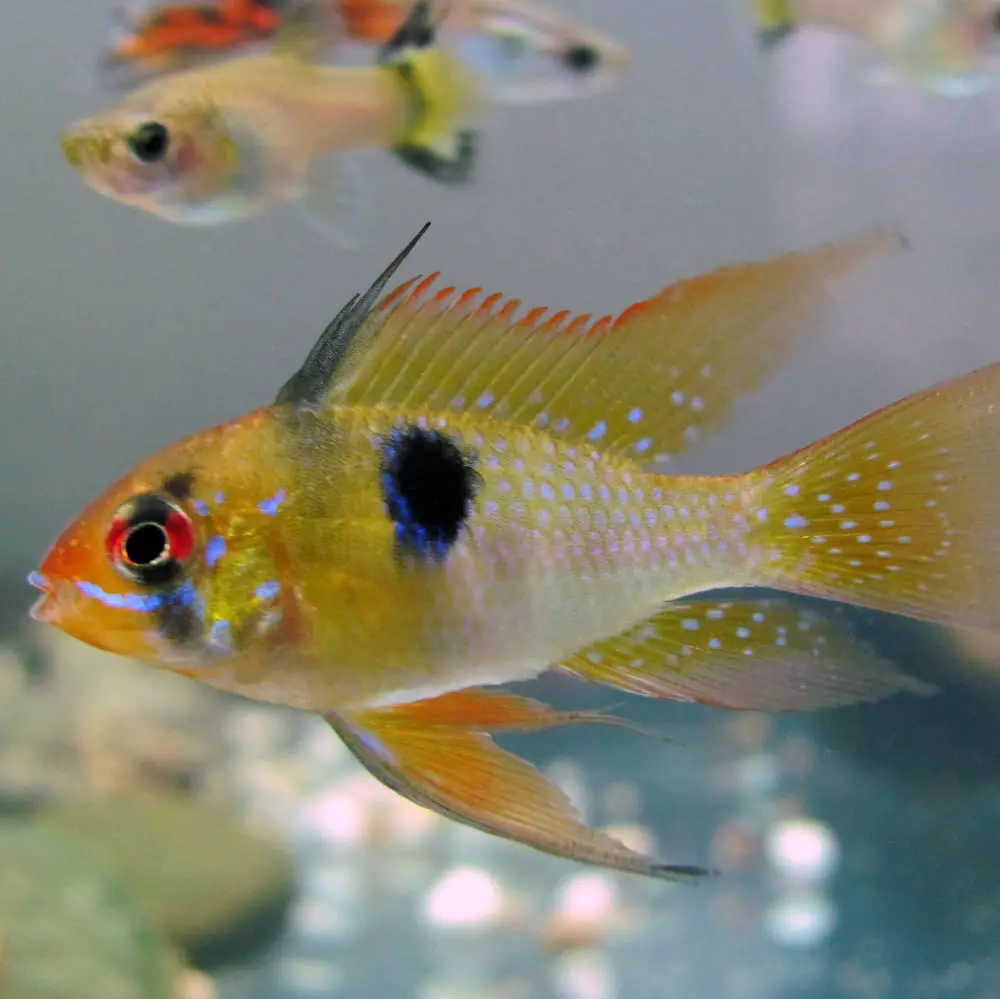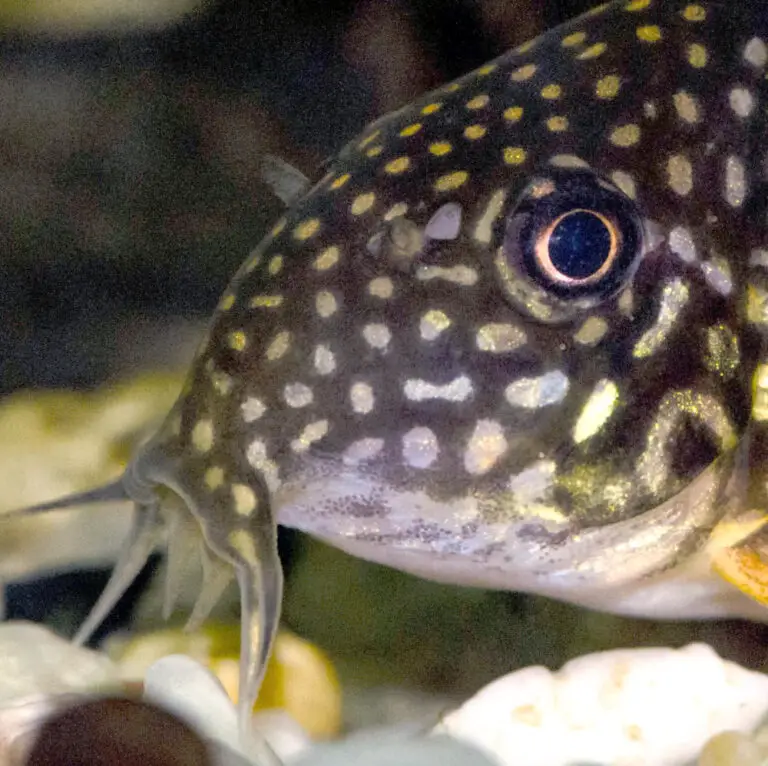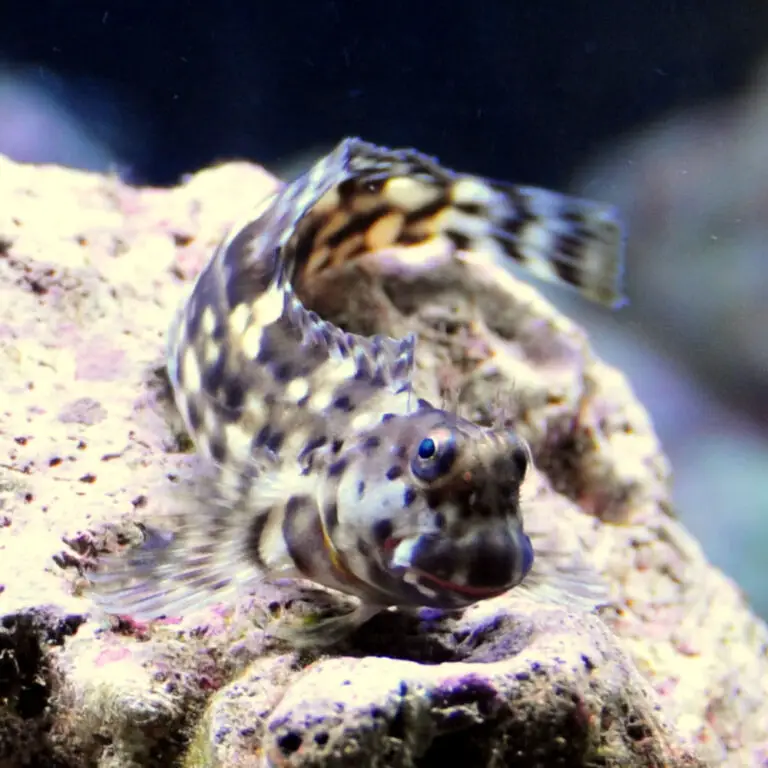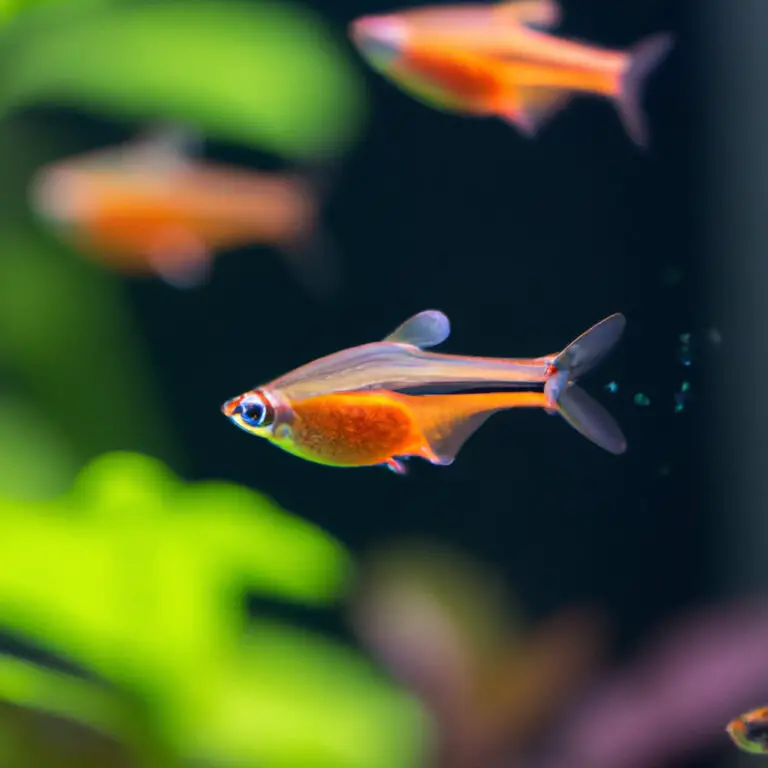The German Blue Ram Cichlid, scientifically known as Mikrogeophagus ramirezi, is a popular freshwater fish among aquarium enthusiasts. Known for its vibrant blue coloration and unique markings, this small cichlid is native to the Amazon River Basin in South America. With its peaceful temperament and manageable size, the German Blue Ram Cichlid is an excellent choice for both beginner and experienced fish keepers.
Characteristics
The German Blue Ram Cichlid is a compact fish with a round body shape. It can grow up to 2-3 inches in length, with females typically being slightly smaller than males. One of the defining characteristics of this fish is its stunning blue coloration, which can vary in intensity depending on the individual fish and its mood. The males typically have longer dorsal and anal fins than the females, and they often display more vivid colors.
Temperament & Behavior
The German Blue Ram Cichlid is generally peaceful and can be kept in community tanks with other small, non-aggressive fish. However, they can become territorial during breeding, so it’s important to provide plenty of hiding places and territories within the aquarium. They are not suited to be kept with larger, more aggressive fish, as they can easily be outcompeted for food or become victims of aggression.
Origin
The German Blue Ram Cichlid is native to the Orinoco River basin in Venezuela and Colombia. It was first discovered in the 1940s and was introduced to the aquarium trade in the 1950s. Since then, it has become a highly sought-after fish due to its stunning appearance and peaceful nature.
Natural Habitat
In the wild, the German Blue Ram Cichlid inhabits slow-moving rivers, streams, and floodplain areas of the Amazon River Basin. It prefers areas with plenty of vegetation and woody debris, as this provides cover and hiding places. The water in its natural habitat is typically warm and soft, with a pH range of 5.0-7.0.
Care
To provide the best care for your German Blue Ram Cichlid, it’s important to replicate its natural habitat as closely as possible. Here are some key care requirements to keep in mind:
- Tank size: A minimum tank size of 20 gallons is recommended for a pair of German Blue Rams. A larger tank will allow for better swimming space and reduce territorial conflicts.
- Water parameters: The ideal water temperature for German Blue Rams is around 78-82°F, with a pH range of 5.0-7.0 and a water hardness of 1-5 dGH.
- Filtration and water quality: German Blue Rams are sensitive to poor water quality, so it’s important to provide a well-maintained aquarium with good filtration. Regular water changes are also necessary to keep the water parameters stable.
- Substrate and decor: Use a fine sand or gravel substrate, as the German Blue Rams like to sift through the substrate in search of food. Include plenty of live plants, driftwood, and rocks to create hiding spots and territories.
- Lighting: Provide a moderate amount of lighting, as too much intensity can cause stress and reduce the vibrant colors of the fish.
- Tank mates: Choose peaceful fish species that can tolerate the warm water and soft water conditions required by the German Blue Rams. Good tank mates include small tetras, dwarf corydoras, and peaceful catfish.
Health & Diseases
The German Blue Ram Cichlid is generally hardy and disease-resistant when kept in optimal conditions. However, poor water quality, improper diet, and stress can make them susceptible to diseases such as ich, fin rot, and bacterial infections. Regular water testing, proper nutrition, and a stress-free environment will help keep your German Blue Rams healthy. If you notice any signs of illness, such as loss of appetite, lethargy, or abnormal behavior, it’s important to take action promptly and consult a fish veterinarian if necessary.
Diet & Feeding
The German Blue Ram Cichlid is an omnivorous fish, and its diet should consist of a variety of foods to ensure optimal health and coloration. Offer a combination of high-quality flake or pellet food, supplemented with frozen or live foods such as brine shrimp, bloodworms, and daphnia. It’s recommended to feed small amounts multiple times a day, as this mimics their natural feeding habits.
Breeding
Breeding German Blue Rams can be a rewarding experience for aquarists. To encourage breeding, provide a pair with their own territory within the aquarium, and maintain optimal water conditions with regular water changes. The male will typically construct a pit in the substrate, where the female will lay the eggs. The male will then fertilize and guard the eggs until they hatch in about 3-4 days. Once the fry hatch, they can be fed with freshly hatched brine shrimp or specialized fry foods.
Places You Find it for Sale
The German Blue Ram Cichlid is readily available in most aquarium stores and online retailers that specialize in tropical fish. It’s important to purchase from reputable sources to ensure the fish is healthy and ethically sourced. Be sure to ask about the source and quarantine practices of the fish before making a purchase.
F.A.Q.
What is a German Blue Ram Cichlid?
The German Blue Ram Cichlid is a small freshwater fish native to the Orinoco River basin in South America. It is highly prized among aquarium enthusiasts for its beautiful colors and peaceful nature.
How big do German Blue Ram Cichlids get?
German Blue Ram Cichlids typically grow to be around 2-3 inches in length.
What colors do German Blue Ram Cichlids come in?
German Blue Ram Cichlids have a bright blue body with black markings on their fins. There are also other color variations, such as gold and electric blue, that have been bred selectively.
What is the ideal water temperature for German Blue Ram Cichlids?
The ideal water temperature for German Blue Ram Cichlids is around 78-82 degrees Fahrenheit.
Do German Blue Ram Cichlids require a heated aquarium?
Yes, German Blue Ram Cichlids are tropical fish and require a heated aquarium to maintain the correct water temperature.
What is the pH range for German Blue Ram Cichlids?
The pH range for German Blue Ram Cichlids is between 5.5 and 7.0.
Can German Blue Ram Cichlids be kept with other fish?
German Blue Ram Cichlids can be kept with other peaceful fish that prefer similar water conditions. However, they can be territorial and may become aggressive towards other small and timid fish.
What kind of tank setup do German Blue Ram Cichlids prefer?
German Blue Ram Cichlids prefer a well-planted aquarium with plenty of hiding spots, such as caves and rocks. They also appreciate a soft substrate, such as sand or fine gravel, as they like to dig.
Are German Blue Ram Cichlids suitable for beginners?
German Blue Ram Cichlids are not recommended for beginners, as they can be more sensitive and require more specific care compared to other freshwater fish.
What do German Blue Ram Cichlids eat?
German Blue Ram Cichlids are omnivores and will eat a variety of foods, including high-quality flakes, pellets, frozen foods, and live foods such as brine shrimp and bloodworms.
How often should I feed my German Blue Ram Cichlids?
German Blue Ram Cichlids should be fed small amounts of food 2-3 times a day.
Can German Blue Ram Cichlids be bred in captivity?
Yes, German Blue Ram Cichlids can be bred in captivity. However, they are known to be more challenging to breed compared to other species.
Do German Blue Ram Cichlids make good parents?
Yes, German Blue Ram Cichlids are known for their exceptional parenting skills. They will guard and care for their eggs and fry diligently.
How long do German Blue Ram Cichlids live?
German Blue Ram Cichlids have an average lifespan of 2-3 years. However, with proper care, they can live up to 5 years or more.
Can German Blue Ram Cichlids be kept in a community tank?
German Blue Ram Cichlids can be kept in a community tank as long as the other fish are peaceful and can tolerate similar water conditions.
Are German Blue Ram Cichlids aggressive?
German Blue Ram Cichlids are generally not aggressive, but they can become territorial, especially when breeding or defending their young.
What tank size is suitable for German Blue Ram Cichlids?
A tank size of at least 20 gallons is recommended for a pair of German Blue Ram Cichlids. Providing more space is always better.
Do German Blue Ram Cichlids jump out of the aquarium?
German Blue Ram Cichlids are not known for being jumpers, but it is still a good idea to have a secure lid on the aquarium to prevent any accidents.
Can German Blue Ram Cichlids be kept in a planted tank?
German Blue Ram Cichlids thrive in a planted tank as they appreciate the natural cover and hiding spots provided by the plants. Just make sure the plants can tolerate the specific water parameters preferred by the fish.
Are German Blue Ram Cichlids prone to any diseases?
German Blue Ram Cichlids can be prone to certain diseases, such as bacterial infections and parasitic infestations. Maintaining good water quality and providing a balanced diet can help prevent these issues.
Do German Blue Ram Cichlids need a filter?
Yes, German Blue Ram Cichlids require a filter in their aquarium to maintain good water quality. A gentle filter with low water flow is preferable to avoid stressing the fish.
What kind of substrate is best for German Blue Ram Cichlids?
A soft substrate, such as sand or fine gravel, is best for German Blue Ram Cichlids as they like to dig and sift through the substrate.
Are German Blue Ram Cichlids finicky eaters?
German Blue Ram Cichlids can sometimes be finicky eaters, especially if they are not accustomed to the food being offered. It may be necessary to try different types of food until you find what they prefer.
Can I keep two male German Blue Ram Cichlids together?
It is not recommended to keep two male German Blue Ram Cichlids together, as they can be territorial and may fight each other. It is best to have one male and one female in a pair or keep them in a larger group.
What is the difference between German Blue Ram Cichlids and Electric Blue Rams?
The German Blue Ram Cichlid is the wild-type coloration of the species, while Electric Blue Rams have been selectively bred for their vibrant blue color.
Can German Blue Ram Cichlids be kept with shrimp?
It is not recommended to keep German Blue Ram Cichlids with shrimp, as the cichlids may see the shrimp as prey and try to eat them.
What is the scientific name of the German Blue Ram Cichlid?
The scientific name of the German Blue Ram Cichlid is Mikrogeophagus ramirezi.
Do German Blue Ram Cichlids need a lot of swimming space?
German Blue Ram Cichlids are not particularly fast swimmers and do not need a lot of open swimming space. They prefer to have plenty of hiding spots and cover instead.
Can German Blue Ram Cichlids be kept in a bare-bottom tank?
While German Blue Ram Cichlids can be kept in a bare-bottom tank, they prefer a soft substrate like sand or fine gravel to dig and sift through.
Can German Blue Ram Cichlids be kept with Angelfish?
Keeping German Blue Ram Cichlids with Angelfish is usually not recommended, as Angelfish can sometimes be aggressive and may bully the smaller cichlids.
Do German Blue Ram Cichlids require a lot of light?
German Blue Ram Cichlids do not require a lot of light and appreciate having areas of dim lighting in the aquarium. This can be achieved by using plants or adding floating plants to provide dappled light.
Can German Blue Ram Cichlids be kept in a community tank with large fish?
It is not recommended to keep German Blue Ram Cichlids with large fish, as the smaller cichlids may be seen as prey by the larger fish.
What is the natural habitat of the German Blue Ram Cichlid?
The German Blue Ram Cichlid is native to the Orinoco River basin in South America. It is often found in slow-moving waters with plenty of vegetation.
Can German Blue Ram Cichlids be housed with bottom-dwelling fish?
German Blue Ram Cichlids can be housed with bottom-dwelling fish as long as they are peaceful and can tolerate similar water conditions.
Are German Blue Ram Cichlids shoaling fish?
German Blue Ram Cichlids are not shoaling fish by nature and do not need to be kept in large groups. However, they can be kept in pairs or small groups as long as there is enough space and hiding spots.
Do German Blue Ram Cichlids require a lot of maintenance?
German Blue Ram Cichlids do not require excessive maintenance, but regular water changes, checking water parameters, and monitoring their health is important to ensure their well-being.
Are German Blue Ram Cichlids jumpers?
German Blue Ram Cichlids are not known for being jumpers, but it is still a good idea to have a secure lid on the aquarium to prevent any accidents.
Can German Blue Ram Cichlids be kept with tetras?
German Blue Ram Cichlids can be kept with peaceful tetras that prefer similar water conditions. However, caution should be taken with smaller tetras, as they may be seen as prey.
Can I keep German Blue Ram Cichlids in a bowl or small container?
No, German Blue Ram Cichlids require a properly sized aquarium with filtration and heating. Keeping them in a bowl or small container would not provide them with adequate space and conditions.
Do German Blue Ram Cichlids have any special care requirements?
German Blue Ram Cichlids require warm water, soft substrate, plenty of hiding spots, and a balanced diet. They can be more sensitive to water conditions, so regular monitoring is important.
How can I tell if a German Blue Ram Cichlid is male or female?
Males often have longer dorsal fins and are more brightly colored than females. Females tend to have a pinkish belly and a shorter, rounder dorsal fin.
Are German Blue Ram Cichlids jumpers?
German Blue Ram Cichlids are not known for being jumpers, but it is still a good idea to have a secure lid on the aquarium to prevent any accidents.
Can German Blue Ram Cichlids be kept in a pond?
No, German Blue Ram Cichlids are tropical fish and require warm water. They are not suitable for outdoor ponds in most climates.
Do German Blue Ram Cichlids require a lot of oxygen in the water?
German Blue Ram Cichlids do not require excessive amounts of oxygen in the water, but having a well-aerated aquarium is always beneficial for the health of the fish.
Can German Blue Ram Cichlids be kept with bettas?
It is not recommended to keep German Blue Ram Cichlids with bettas, as the two species can be aggressive towards each other. They may end up fighting or stressing each other out.
Can German Blue Ram Cichlids be kept in a brackish water tank?
No, German Blue Ram Cichlids are freshwater fish and should not be kept in brackish water. They require specific water parameters found in freshwater environments.
Can German Blue Ram Cichlids be kept with other cichlid species?
German Blue Ram Cichlids can be kept with other peaceful cichlid species that prefer similar water conditions. However, it is best to avoid larger or more aggressive cichlids.
Can German Blue Ram Cichlids be kept in a community tank with guppies?
German Blue Ram Cichlids can be kept in a community tank with guppies as long as the guppies are not small enough to be considered prey by the cichlids.
Can German Blue Ram Cichlids be kept with snails?
German Blue Ram Cichlids can be kept with snails, as they generally do not see them as threats or prey. Just be aware that some snails can reproduce rapidly and may overpopulate the tank if not controlled.
Can German Blue Ram Cichlids be kept in a saltwater tank?
No, German Blue Ram Cichlids are freshwater fish and should not be kept in a saltwater tank. The high salinity and different water parameters would be harmful to them.
What is the best tank setup for breeding German Blue Ram Cichlids?
The best tank setup for breeding German Blue Ram Cichlids includes a flat stone or spawning slate for them to lay their eggs on. Provide plenty of hiding spots and ensure stable water conditions to encourage successful breeding.
Can I keep German Blue Ram Cichlids with live plants?
Yes, German Blue Ram Cichlids can be kept with live plants. They can even benefit from the plants as they provide cover and create a more natural environment.
Are German Blue Ram Cichlids sensitive to water parameters?
German Blue Ram Cichlids can be more sensitive to water parameters compared to other freshwater fish. It is important to monitor ammonia, nitrite, and nitrate levels regularly and perform regular water changes to maintain good water quality.
What is the recommended tank temperature for breeding German Blue Ram Cichlids?
The recommended tank temperature for breeding German Blue Ram Cichlids is around 80-84 degrees Fahrenheit. This can help stimulate their breeding behavior.
Conclusions
The German Blue Ram Cichlid is a stunning and peaceful fish that makes a great addition to any freshwater aquarium. With proper care and attention to its unique requirements, this fish can thrive and reward you with its vibrant colors and fascinating behavior. Whether you are a beginner or an experienced fish keeper, the German Blue Ram Cichlid is sure to bring joy and beauty to your aquarium.




